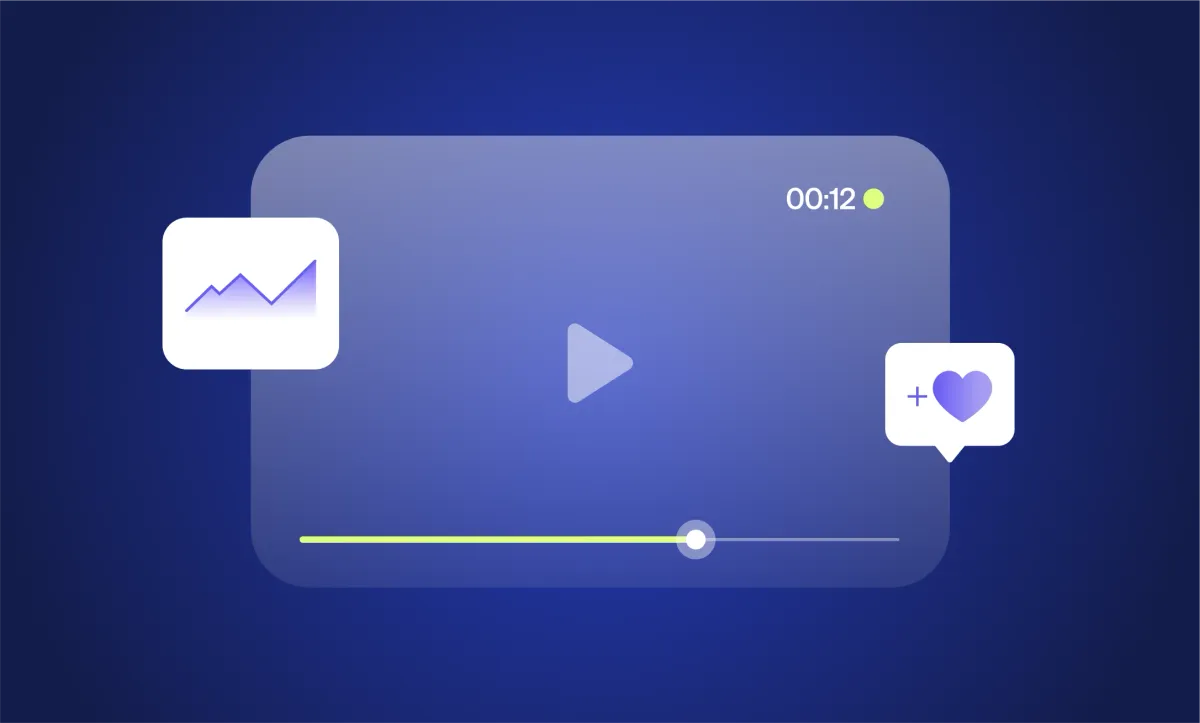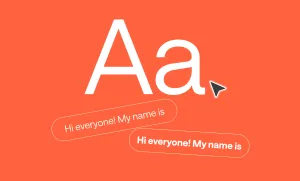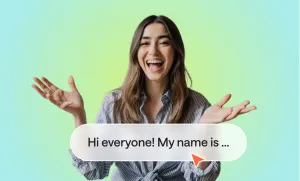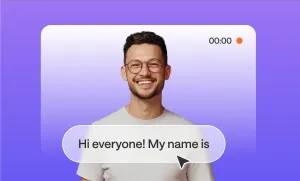Going viral in 2025 isn’t just about luck. There's a fair bit of strategy, psychology, and consistency that goes along with it.
With more content being uploaded than ever before, breaking through the noise requires a mix of creativity and calculated moves.
But here’s the good news: virality is no longer an unpredictable mystery. In fact, many of today’s most viral videos follow recognizable patterns that you can learn, replicate, and adapt to your unique style.
This guide will cover:
- What makes a video go viral in 2025 (emotions, editing, engagement metrics)
- How to engineer the perfect short-form video from hook to final cut
- 10 proven strategies to boost reach across TikTok, Reels, and YouTube Shorts
- Why consistency beats luck, and how to show up without burning out
- How to edit viral-ready content fast using Podcastle’s free video tools
Listen to this article
What Makes a Video Go Viral in 2025?
In 2025, viral videos aren’t just happy accidents; they’re the result of careful storytelling, emotional resonance, and smart optimization. Sure, there’s still an element of timing and luck involved, but most viral content follows a clear set of patterns. If you understand what makes people watch, react, and share, you can intentionally boost your chances of striking gold.
So what exactly does “going viral” mean today?
At its core, a viral video is one that spreads rapidly and organically, often across multiple platforms. It doesn’t rely solely on paid promotion or follower count; instead, it taps into human psychology and platform algorithms to reach beyond its original audience. This happens when a video is so entertaining, relatable, emotional, or surprising that viewers feel compelled to watch it all the way through, send it to friends, save it for later, or rewatch it again and again.
Key Metrics That Signal a Viral Video
Algorithms on platforms like TikTok, Instagram Reels, and YouTube Shorts have become incredibly sophisticated. They're constantly monitoring signals like:
- High Watch Time & Retention: The best-performing videos hold viewers' attention from beginning to end. On TikTok, the average viral video has a retention rate over 70%, with many being watched on loop. If people are rewatching your video, even better.
- Share Ratio: When users actively share a video (especially in DMs or Stories), that’s a major green flag to the algorithm. A share-to-like ratio over 1:2 typically means your content is striking a nerve.
- Comment-to-View Rate: High comment engagement means your video sparked curiosity, emotion, or debate. The more people talk about it, the more the algorithm pays attention.
- Saves and Bookmarks: On Instagram and YouTube Shorts, saves are a powerful signal. They indicate that your content has lasting value, whether it's funny, educational, or just worth a second look.
Pro Tip: Watch time, shares, and saves are the magic combo. A video with decent likes but no saves or replays? Probably won’t take off.
Emotional Triggers That Drive Virality
Viral videos in 2025 are often less about perfect production and more about emotional impact. If your content makes someone feel something, and they want to act on that feeling, you’ve won.
Here are the emotional levers that still work wonders:
- Surprise & Humor: Unexpected twists, punchlines, or absurd humor catch viewers off guard and keep them engaged. Think of those TikToks where the caption says one thing, and the ending flips it on its head.
- Relatability: “That’s so me” content continues to thrive. Creators who expose awkward truths, daily habits, or personal quirks in a funny or honest way instantly connect with audiences.
- Inspiration & Transformation: Motivational glow-ups, side hustle journeys, or wellness transformations tug at the “if they can do it, maybe I can too” instinct. These often go viral because they’re uplifting and shareable.
- Controlled Controversy: Mild hot takes, unpopular opinions, or open-ended questions ("Do you agree?") spark engagement without being divisive. Audiences love to weigh in, and that means more comments, more views.
Fun fact: According to Later, videos under 60 seconds that use a trending sound, rapid pacing, and a clear narrative are 3x more likely to go viral compared to longer, unfocused clips.
Platform-Specific Factors for Going Viral
Each social platform also has its own rules and quirks:
- TikTok: Prioritizes watch time, replays, and use of trending audio. You don’t need a following; if your content performs well with a small test audience, it can reach millions overnight.
- Instagram Reels: Saves and shares are the strongest indicators. A clean visual style, strong text overlays, and relatable humor do especially well here.
- YouTube Shorts: CTR (click-through rate) and AVD (average view duration) matter most. Crafting compelling thumbnails and titles, even for Shorts, can boost discoverability.
Going viral isn’t magic; it’s about understanding what people feel, what they want to share, and what the algorithm wants to see. Now that you know the “why,” let’s dive into the “how” and break down the exact ingredients every viral video needs.
The Core Ingredients of a Viral Video
Going viral isn’t just about posting at the right time or using the latest trending sound; it starts with how you structure your video. The most successful videos in 2025 share a few key elements: a strong hook, content that hits emotionally or intellectually, tight editing, and a reason to rewatch or share.
Let’s break down the must-have ingredients for crafting scroll-stopping content:
1. A Killer Hook in the First 3 Seconds
The average user decides whether to keep watching within the first half-second. You need to stop the scroll immediately, and that means opening strong with something unexpected, intriguing, or emotionally triggering.
Think bold statements, surprising visuals, or curiosity gaps.
Examples:
“You’ve been brushing your teeth wrong your whole life…” - this kind of bold claim instantly hooks by creating suspense and a bit of controversy. It begs the question: Wait, what have I been doing wrong?
Split-screen before/after shots - wildly effective in beauty, fitness, and home renovation content. If you see a “before” and a dramatic “after” side by side, it’s nearly impossible not to watch how it happened.
Other hook tactics that work:
- Start with a weird facial expression or unexpected noise
- Ask a polarizing question (“Is it just me, or…?”)
- Flash bold text on screen with high-contrast colors
Bottom line: The hook isn’t just about what you say, it’s about the feeling you trigger in the viewer right away.
2. Relatable or Surprising Content
Once you’ve hooked your audience, you need to keep them invested. That’s where relatability and surprise come in.
Relatable videos trigger a “same here” moment; they reflect a universal truth, an awkward experience, or a quirky observation that viewers can immediately connect with. On the flip side, surprising content grabs attention by breaking expectations, revealing hidden truths, or presenting something weirdly specific in a funny or thought-provoking way.
Example:
Elyse Myers became a TikTok icon with her deadpan storytime videos about awkward social encounters. Her storytelling is so relatable and raw that it feels like watching a friend vent over coffee, but funnier.
Other types of relatable/surprising content that tend to go viral:
- Niche internet humor (like hyper-specific “POV” jokes)
- Reversals (e.g., “I thought I aced the job interview… until she said this.”)
- Personal confessions or “I never told anyone this” stories
3. Fast Pacing and Jump Cuts
Attention spans are shorter than ever, and platforms know it. That’s why fast-paced editing is essential. Even if your video is just you talking to the camera, you can make it 10x more engaging with a few simple editing tricks.
- Jump cuts: Cut out pauses, filler words, or redundant thoughts. This keeps your delivery tight and makes even a basic story feel more compelling.
- On-beat edits: Match your cuts to music beats or motion; this gives your video rhythm and makes it feel dynamic.
- Text overlays, emojis, zooms, and pop-ups: Use these sparingly to highlight key points and break up the visual monotony.
Example:
Creators like @corporatenatalie often post talking-head skits that feel fast, fun, and highly watchable, not because they’re high-budget, but because the pacing is sharp and there’s zero wasted time.
Even educational or how-to content benefits from this. A tutorial with quick steps, bold captions, and no awkward silences will always outperform a slower, unedited version.
4. Repeatability and Replay Value
One underrated ingredient in viral videos? They make you watch them more than once, and not just because they’re short. The best videos are crafted with layers that reward rewatching.
Here’s how to build replay value into your content:
- Speed up the text just enough so viewers have to rewatch to catch everything
- Add visual Easter eggs, like a small joke or reaction happening in the background
- Loop the video seamlessly so it restarts without anyone noticing
- Include a surprise ending that flips the context of everything they just watched
Example:
One viral cooking creator adds unexpected sound effects and subtitles that move so fast, you end up watching three times just to catch the jokes. Others, like beauty influencers, hide bloopers or reactions mid-transformation.
The goal? Make viewers feel like they missed something, and need to see it again.
When you combine a killer hook, emotionally resonant content, dynamic editing, and replayable structure, you don’t just create a video, you create an experience. And that’s what people share.
10 Practical Tips to Maximize Reach
Creating a great video is just step one. To actually get people to see, share, and engage with it, you need to think about timing, format, and platform behavior. These 10 practical tips will help you boost your content’s reach, without needing a huge budget or following.
1. Post at Peak Hours
Timing can make or break your video’s initial performance. The faster you get views and interactions after posting, the more likely the algorithm will push your content.
Here’s a general rule of thumb:
- TikTok: 6-10 PM
- Instagram: 5-7 PM
- YouTube Shorts: Noon and 7 PM
Your actual sweet spot may vary, so check your account insights regularly to see when your audience is most active.
2. Use Trending Sounds
Using trending audio increases the chance of your video showing up in more feeds. Even if it’s just background noise, popular sounds tell the platform that your video is “current.”
Scroll through your platform’s trending section and save sounds that are getting traction. You can even record your video and add the sound later during editing.
3. Capitalize on Popular Formats
Certain video structures consistently perform well because they create familiarity for the viewer. Try using formats like:
- “Day in My Life”
- “Things I Wish I Knew Before…”
- “Unpopular Opinion”
- “3 Mistakes I Made When…”
The trick is to add your own spin. A familiar structure with a unique point of view is often a winning combo.
4. Optimize for Mobile
Over 90% of short-form videos are watched on phones, so your video needs to look good vertically. Shoot and edit in a 9:16 aspect ratio, use large text that’s easy to read on small screens, and make sure key visuals are centered.
Avoid cluttered frames or long blocks of on-screen text that people won’t have time to read.
5. Nail the Thumbnail and Caption
Think of your thumbnail and caption as your video’s headline. On TikTok and YouTube Shorts, the opening frame and cover image should hint at the payoff: transformation, surprise, or emotion.
For captions, lead with curiosity or emotion. Questions, cliffhangers, or short, punchy statements work best.
Example: “I tried waking up at 5 AM for a week, here’s what happened.”
6. Loop It Smartly
The best viral videos don’t feel like they end; they loop. By starting and ending your video with the same visual or phrase, you can create a seamless loop that makes people rewatch without even realizing it.
This increases retention time, which platforms love. If your video loops smoothly and keeps people watching twice or more, that’s a strong viral signal.
7. Encourage Comments
The more comments you get, the more the algorithm thinks people care. A simple question or a slightly controversial take can drive tons of replies.
Try ending your video with a prompt:
- “Agree or disagree?”
- “What would you do in this situation?”
- “Did this happen to anyone else?”
Make it easy and fun for people to respond.
8. Crosspost Everywhere
Don’t leave the reach on the table. That 30-second TikTok can also work as an Instagram Reel, YouTube Short, Pinterest Idea Pin, or even a LinkedIn post if it’s educational or inspiring.
Different platforms have different audiences and algorithms; maximize your chances by showing up in more places.
9. Add Subtitles
Most people scroll in silence. Over 85% of social video views happen with the sound off, so captions are non-negotiable.
Use bold, high-contrast text and keep it concise. Bonus: Subtitles also boost accessibility and watch time.
10. Batch and Repurpose Content
Work smarter, not harder. Record multiple clips in one shoot, then edit them into separate videos with different hooks. One long video can be broken into a carousel, a GIF, a meme, or even a blog post.
This keeps your content calendar full and helps you get more mileage from every shoot.
How to Create Social Media Content with Podcastle’s Video Editor
Creating viral content doesn't mean spending hours in Premiere or Final Cut. Podcastle’s built-in video editor makes it easy to create, edit, and repurpose short-form videos, no experience required.
Here’s how to use it:
Step 1: Upload Your Video
Start by uploading your raw video file directly to Podcastle’s video editor. You can drag and drop your footage into the browser-based workspace, no downloads needed. Once uploaded, you’ll be able to trim, enhance, and format it for any social platform with ease.
Step 2: Resize for Any Platform
Use the Instant Resizing tool to convert your content to TikTok, Reels, or YouTube Shorts format (9:16). You can also repurpose it to horizontal for YouTube or landscape for LinkedIn.
Step 3: Add Stock Footage, B-Roll, or GIFs
Need to spice things up? Podcastle includes a built-in library of royalty-free stock videos, reaction GIFs, and background clips. Just drag and drop.
Step 4: Remove or Blur the Background
With the AI Background Remover, you can isolate your face or blur your surroundings, perfect for working from messy spaces or adding branded visuals.
Step 5: Add Captions and Text Overlays
Auto-generate subtitles with Podcastle’s speech-to-text engine. Customize the font, color, and placement to match your brand or keep it platform-native.
Step 8: Export and Share
Download your video in high quality and share it on your preferred platform. Boom, done in minutes.
Final Thoughts: Consistency Beats Virality
Going viral is exciting. It feels like winning the internet lottery. Suddenly, your content is everywhere, your follower count spikes, and new opportunities start rolling in. But here’s the truth: virality is unpredictable. What is in your control is how consistently and strategically you show up.
For creators and professionals, long-term growth comes from showing up again and again with valuable, engaging, and well-crafted videos. Every post is a chance to learn what resonates, refine your voice, and build trust with your audience. Over time, the algorithm starts to recognize how your content performs, and that’s when you start to see momentum.
And the best part? You don’t have to do it all from scratch or spend hours editing. With tools like Podcastle, you can streamline your workflow, stay consistent, and create content that stands out on any platform. From instant video resizing to background removal and built-in stock visuals, Podcastle makes it easier to go from idea to polished post in minutes.
Ready to create scroll-stopping content without the burnout? Try Podcastle’s video tools today, free to start, and powerful enough to grow with you.
Start editing with Podcastle now and bring your content to life.








